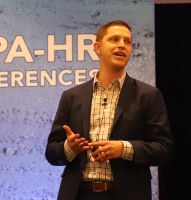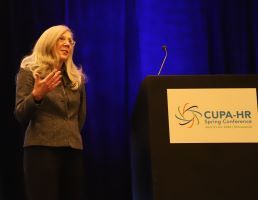by CUPA-HR | July 31, 2024
The road home may have been a bit bumpy (thanks, CrowdStrike), but the two days CUPA-HR leaders spent in Kansas City at the annual Association Leadership Program (ALP) were packed with opportunities to smooth the way for higher ed HR in the year ahead.
On July 18-19, leaders from CUPA-HR’s national, region and chapter boards; cohorts from the Ignite and Emerging CUPA-HR Leaders programs; team members from the CUPA-HR national office; and key corporate partners gathered to discuss higher ed HR challenges, share successes, learn from one another, and build relationships. Here are some of the takeaways from this year’s event:
- To be relevant and effective, higher education HR leaders must partner with their presidents and other campus leaders to connect their work to the institution’s mission and priorities and to understand current and emerging challenges for higher education.
- CUPA-HR chapters are knocking it out of the park when it comes to creating information-packed programs to support higher ed HR professionals at the local level.
- The key to creating and sustaining inclusive campus communities is to focus on processes, policies, and learning opportunities that mitigate bias and promote belonging and civil discourse for all. CUPA-HR resources are available to support this work!
- Gender gaps in leadership positions persist. To expand the pipeline for leadership positions to include more women, start by reviewing promotion processes and criteria to mitigate bias and by training decision makers to recognize bias.
- CUPA-HR higher ed workforce data is second to none, and the Research Center is an excellent source of high-level data to support workforce planning.
- To promote civility and build authentic relationships in the workplace, speaker Alonzo Kelly emphasized the importance of:
- Entering conversations with humility
- Keeping in mind that your information may not be wrong, but may be incomplete
- Being direct and kind
- “A mistake repeated is a decision.”
- CUPA-HR leaders lead because they are drawn to service, they are lifelong learners, and they value the friendships they’ve formed and the support they receive from the CUPA-HR community.
 You can take CUPA-HR with you wherever you go — especially if you have a Roamin’ Robyn to keep you company. Think “Flat Stanley,” but featuring CUPA-HR’s board chair, Robyn Salvo! (Thanks to Joanne Santarelli for the awesome photo!)
You can take CUPA-HR with you wherever you go — especially if you have a Roamin’ Robyn to keep you company. Think “Flat Stanley,” but featuring CUPA-HR’s board chair, Robyn Salvo! (Thanks to Joanne Santarelli for the awesome photo!)
Interested in Taking Your Professional Development Further?
CUPA-HR’s volunteer leaders have committed to advancing the profession and the mission of CUPA-HR. They understand the complexities of higher ed HR, and they want to enhance the knowledge and skills they need to lead their institutions into the future.
Are you ready to take that next step in developing your leadership skills, shaping the profession, and gaining one-of-a-kind access to successful practices and HR professionals from across the country? Then CUPA-HR leadership — in a chapter, at the region level, or even on the national board of directors — might be right for you. Learn more about how you can get involved.











